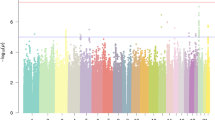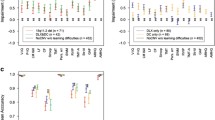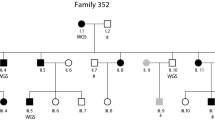Abstract
It has been repeatedly shown that mismatch negativity (MMN), an event related potential measurement, reveals differences between dyslexic children and age-matched controls. MMN reflects the automatic detection of deviance between a stream of incoming sounds presented to the passive listener, and deficits in MMN (i.e. attenuated amplitudes) have been especially reported in dyslexia for detecting differences between speech sounds (e.g./ba/vs./da/). We performed an association analysis in 200 dyslexic children. This analysis focused on two MMN components, an early MMN (188–300 ms) and a late MMN (300–710 ms), and the dyslexia candidate genes KIAA0319 and DCDC2 on chromosome 6. Additionally, we imputed rare variants located in this region based on the 1000 genomes project. We identified four rare variants that were significantly associated with the late MMN component. For three of these variants, which were in high LD to each other, genotyping confirmed the association signal. Our results point to an association between late MMN and rare variants in a candidate gene region for dyslexia.



Similar content being viewed by others
References
Alonso-Bua B, Diaz F, Ferraces M (2006) The contribution of AERPs (MMN and LDN) to studying temporal vs. linguistic processing deficits in children with reading difficulties. Int J Psychophysiol 59:159–167
Bishop DV (2007) Using mismatch negativity to study central auditory processing in developmental language and literacy impairments: where are we, and where should we be going? Psychol Bull 133:651–672
Blau V, van Atteveldt N, Ekkebus M, Goebel R, Blomert L (2009) Reduced neural integration of letters and speech sounds links phonological and reading deficits in adult dyslexia. Curr Biol 19:503–508
Bruford EA, Lush MJ, Wright MW, Sneddon TP, Povey S, Birney E (2008) The HGNC database in 2008: a resource for the human genome. Nucleic Acids Res 36:D445–D448
Burbridge T, Wang Y, Volz A, Peschansky V, Lisann L, Galaburda A, LoTurco J, Rosen G (2008) Postnatal analysis of the effect of embryonic knockdown and overexpression of candidate dyslexia susceptibility gene homolog DCDC2 in the rat. Neuroscience 152:723–733
Cannon TD, Keller MC (2006) Endophenotypes in the genetic analyses of mental disorders. Annu Rev Clin Psychol 2:267–290
Ceponiene R, Yaguchi K, Shestakova A, Alku P, Suominen K, Naatanen R (2002) Sound complexity and ‘speechness’ effects on pre-attentive auditory discrimination in children. Int J Psychophysiol 43:199–211
Ceponiene R, Lepisto T, Soininen M, Aronen E, Alku P, Naatanen R (2004) Event-related potentials associated with sound discrimination versus novelty detection in children. Psychophysiology 41:130–141
Cheour M, Korpilahti P, Martynova O, Lang AH (2001) Mismatch negativity and late discriminative negativity in investigating speech perception and learning in children and infants. Audiol Neurootol 6:2–11
Computerized Speech Research Environment (1995) www.speech.cs.cmu.edu/comp.speech/Section5/Synth/csre.html
Cope N, Harold D, Hill G, Moskvina V, Stevenson J, Holmans P, Owen M, O’Donovan M, Williams J (2005) Strong evidence that KIAA0319 on chromosome 6p is a susceptibility gene for developmental dyslexia. Am J Hum Genet 76:581–591
Corbera S, Escera C, Artigas J (2006) Impaired duration mismatch negativity in developmental dyslexia. Neuroreport 17:1051–1055
Deffenbacher K, Kenyon J, Hoover D, Olson R, Pennington B, DeFries J, Smith S (2004) Refinement of the 6p21.3 quantitative trait locus influencing dyslexia: linkage and association analyses. Hum Genet 115:128–138
Francks C, Paracchini S, Smith SRA, Scerri T, Cardon LMA, MacPhie I, Walter JPB, Fisher S, Olson R, DeFries J, Stein J, Monaco A (2004) A 77-kilobase region of chromosome 6p22.2 is associated with dyslexia in families from the United Kingdom and from the United States. Am J Hum Genet 75:1046–1058
Froyen DJ, Bonte ML, van AN, Blomert L (2009) The long road to automation: neurocognitive development of letter-speech sound processing. J Cogn Neurosci 21:567–580
Galaburda AM, Kemper TL (1979) Cytoarchitectonic abnormalities in developmental dyslexia: a case study. Ann Neurol 6:94–100
Galaburda AM, Sherman GF, Rosen GD, Aboitiz F, Geschwind N (1985) Developmental dyslexia: four consecutive patients with cortical anomalies. Ann Neurol 18:222–233
Galaburda A, LoTurco J, Ramus F, Fitch R, Rosen G (2006) From genes to behavior in developmental dyslexia. Nat Neurosci 9:1213–1217
Goldston DB, Walsh A, Mayfield AE, Reboussin B, Sergent DS, Erkanli A, Nutter D, Hickman E, Palmes G, Snider E, Wood FB (2007) Reading problems, psychiatric disorders, and functional impairment from mid- to late adolescence. J Am Acad Child Adolesc Psychiatry 46:25–32
Guttorm TK, Leppanen PH, Hamalainen JA, Eklund KM, Lyytinen HJ (2009) Newborn event-related potentials predict poorer pre-reading skills in children at risk for dyslexia. J Learn Disabil 43(5):391–401
Hall M, Schulze K, Rijsdijk F, Picchioni M, Ettinger U, Bramon E, Freedman R, Murray R, Sham P (2006) Heritability and reliability of P300, P50 and duration mismatch negativity. Behav Genet 36:845–857
Harold D, Paracchini S, Scerri T, Dennis M, Cope N, Hill G, Moskvina V, Walter J, Richardson A, Owen M, Stein J, Green E, O’Donovan M, Williams J, Monaco A (2006) Further evidence that the KIAA0319 gene confers susceptibility to developmental dyslexia. Mol Psychiatry 11:1085–1091
Hommet C, Vidal J, Roux S, Blanc R, Barthez M, De Becque B, Barthelemy C, Bruneau N, Gomet M (2009) Topography of syllable change-detection electrophysiological indices in children and adults with reading disabilities. Neuropsychologia 47:761–770
Hornickel J, Skoe E, Nicol T, Zecker S, Kraus N (2009) Subcortical differentiation of stop consonants relates to reading and speech-in-noise perception. Proc Natl Acad Sci USA 106:13022–13027
Humphreys P, Kaufmann WE, Galaburda AM (1990) Developmental dyslexia in women: neuropathological findings in three patients. Ann Neurol 28:727–738
Huttunen-Scott T, Kaartinen J, Tolvanen A, Lyytinen H (2008) Mismatch negativity (MMN) elicited by duration deviations in children with reading disorder, attention deficit or both. Int J Psychophysiol 69:69–77
Jessen F, Fries T, Kucharski C, Nishimura T, Hoenig K, Maier W, Falkai P, Heun R (2001) Amplitude reduction of the mismatch negativity in first-degree relatives of patients with schizophrenia. Neurosci Lett 309:185–188
Korpilahti P, Lang HA (1994) Auditory ERP components and mismatch negativity in dysphasic children. Electroencephalogr Clin Neurophysiol 91:256–264
Korpilahti P, Krause C, Holopainen I, Lang A (2001) Early and late mismatch negativity elicited by words and speech-like stimuli in children. Brain Lang 76:332–339
Kujala T, Tervaniemi M, Schröger E (2007) The mismatch negativity in cognitive and clinical neuroscience: theoretical and methodological considerations. Biol Psychol 74:1–19
Lachmann T, Berti S, Kujala T, Schröger E (2005) Diagnostic subgroups of developmental dyslexia have different deficits in neural processing of tones and phonemes. Int J Psychophysiol 56:105–120
Leppänen PH, Pihko E, Eklund KM, Lyytinen H (1999) Cortical responses of infants with and without a genetic risk for dyslexia: II. Group effects. Neuroreport 10:969–973
Lovio R, Naatanen R, Kujala T (2010) Abnormal pattern of cortical speech feature discrimination in 6-year-old children at risk for dyslexia. Brain Res 1335:53–62
Ludwig K, Roeske D, Schumacher J, Schulte-Körne G, König I, Warnke A, Plume E, Ziegler A, Remschmidt H, Müller-Myhsok B, Nöthen M, Hoffmann P (2008) Investigation of interaction between DCDC2 and KIAA0319 in a large German dyslexia sample. J Neural Transm 115:1587–1589
Lyytinen H, Aro M, Eklund K, Erskine J, Guttorm T, Laakso ML, Leppänen PH, Lyytinen P, Poikkeus AM, Torppa M (2004) The development of children at familial risk for dyslexia: birth to early school age. Ann Dyslexia 54:184–220
Maurer U, Bucher K, Brem S, Brandeis D (2003) Altered responses to tone and phoneme mismatch in kindergartners at familial dyslexia risk. Neuroreport 14:2245–2250
Maurer U, Brem S, Bucher K, Kranz F, Benz R, Steinhausen HC, Brandeis D (2007) Impaired tuning of a fast occipito-temporal response for print in dyslexic children learning to read. Brain 130:3200–3210
Maurer U, Bucher K, Brem S, Benz R, Kranz F, van der Mark S, Steinhausen H, Brandeis D (2009) Neurophysiology in preschool improves behavioral prediction of reading ability throughout primary school. Biol Psychiatry 66:341–348
McCandliss BD, Noble KG (2003) The development of reading impairment: a cognitive neuroscience model. Ment Retard Dev Disabil Res Rev 9:196–204
Meng H, Smith S, Hager K, Held M, Liu J, Olson R, Pennington B, DeFries J, Gelernter J, O’Reilly-Pol T, Somlo S, Skudlarski P, Shaywitz S, Shaywitz B, Marchione K, Wang Y, Paramasivam M, LoTurco J, Page G, Gruen J (2005) DCDC2 is associated with reading disability and modulates neuronal development in the brain. Proc Natl Acad Sci USA 102:17053–17058
Moll K, Landerl K (2010) SLRTII Lese- und Rechtschreibtest. Huber, Bern
Mugnaini D, Lassi S, La MG, Albertini G (2009) Internalizing correlates of dyslexia. World J Pediatr 5:255–264
Näätänen R (1982) Processing negativity: an evoked-potential reflection of selective attention. Psychol Bull 92:605–640
Näätänen R, Gaillard A (1983) The orienting reflex and the N2 deflection of the event-related potential (ERP). In: Gaillard A, Ritter W (eds) Tutorials in event related potential research: endogenous components. Amsterdam, North Holland, pp 119–141
Näätänen R, Gaillard A, Mäntysalo S (1978) Early selective-attention effect on evoked potential reinterpreted. Acta Psychol 42:313–329
Näätänen R, Lehtokoski A, Lennes M, Cheour M, Huotilainen M, Iivonen A, Vainio M, Alku P, Ilmoniemi RJ, Luuk A, Allik J, Sinkkonen J, Alho K (1997) Language-specific phoneme representations revealed by electric and magnetic brain responses. Nature 385:432–434
Näätänen R, Paavilainen P, Rinne T, Alho K (2007) The mismatch negativity (MMN) in basic research of central auditory processing: a review. Clin Neurophysiol 118:2544–2590
Paracchini S, Steer C, Buckingham L, Morris A, Ring S, Scerri T, Stein J, Pembrey M, Ragoussis J, Golding J, Monaco A (2008) Association of the KIAA0319 dyslexia susceptibility gene with reading skills in the general population. Am J Psychiatry 165:1576–1584
Rinne T, Alho K, Ilmoniemi RJ, Virtanen J, Naatanen R (2000) Separate time behaviors of the temporal and frontal mismatch negativity sources. Neuroimage 12:14–19
Roeske D, Ludwig K, Neuhoff N, Becker J, Bartling J, Bruder J, Brockschmidt F, Warnke A, Remschmidt H, Hoffmann P, Müller-Myhsok B, Nöthen M, Schulte-Körne G (2009) First genome-wide association scan on neurophysiological endophenotypes points to trans-regulation effects on SLC2A3 in dyslexic children. Mol Psychiatry. doi:10.1038/mp.2009.102
Sams M, Paavilainen P, Alho K, Näätänen R (1985) Auditory frequency discrimination and event-related potentials. Electroencephalogr Clin Neurophysiol 62:437–448
Scerri T, Schulte-Körne G (2010) Genetics of developmental dyslexia. Eur Child Adolesc Psychiatry 19(3):179–197
Schulte-Körne G (2001) Lese- und Rechtschreibstörung––Psychometrische und neurophysiologische Untersuchungen zur Legasthenie. Waxman, Münster
Schulte-Körne G, Bruder J (2010) Clinical neurophysiology of visual and auditory processing in dyslexia: a review. Clin Neurophysiol 121(11):1794–809
Schulte-Körne G, Deimel W, Bartling J, Remschmidt H (1998a) Auditory processing and dyslexia: evidence for a specific speech processing deficit. Neuroreport 9:337–340
Schulte-Körne G, Grimm T, Nöthen M, Müller-Myhsok B, Cichon S, Vogt I, Propping P, Remschmidt H (1998b) Evidence for linkage of spelling disability to chromosome 15. Am J Hum Genet 63:279–282
Schulte-Körne G, Deimel W, Bartling J, Remschmidt H (1999) The role of phonological awareness, speech perception, and auditory temporal processing for dyslexia. ECAP Suppl 8:28–34
Schulte-Körne G, Deimel W, Remschmidt H (2001a) Diagnosis of reading and spelling disorder. Zeitschrift für Kinder- und Jugendpsychiatrie und Psychotherapie 29:113–116
Schulte-Körne G, Deimel W, Bartling J, Remschmidt H (2001b) Speech perception deficit in dyslexic adults as measured by mismatch negativity (MMN). Int J Psychophysiol 40:77–87
Schulte-Körne G, Ziegler A, Deimel W, Schumacher J, Plume E, Bachmann C, Kleensang A, Propping P, Nöthen M, Warnke A, Remschmidt H, König I (2007) Interrelationship and familiality of dyslexia related quantitative measures. Ann Hum Genet 71:160–175
Schumacher J, Anthoni H, Dahdouh F, König I, Hillmer A, Kluck N, Manthey M, Plume E, Warnke A, Remschmidt H, Hülsmann J, Cichon S, Lindgren C, Propping P, Zucchelli M, Ziegler A, Peyrard-Janvid M, Schulte-Körne G, Nöthen M, Kehre J (2006) Strong genetic evidence of DCDC2 as a susceptibility gene for dyslexia. Am J Hum Genet 78:52–62
Sharma M, Purdy S, Newall P, Wheldall K, Beaman R, Dillon H (2006) Electrophysiological and behavioural evidence of auditory processing deficits in children with reading disorder. Clin Neurophysiol 117:1130–1144
Shaywitz S, Morris R, Shaywitz B (2008) The education of dyslexic children from childhood to young adulthood. Annu Rev Psychol 59:451–475
Shestakova A, Huotilainen M, Ceponiene R, Cheour M (2003) Event-related potentials associated with second language learning in children. Clin Neurophysiol 114:1507–1512
Tiitinen H, May P, Reinikainen K, Näätänen R (1994) Attentive novelty detection in humans is governed by pre-attentive sensory memory. Nature 372:90–92
Unnewehr S, Schneider S, Margraf J (1998) Kinder-DIPS: diagnostisches Interview bei psychischen Störungen von Kindern und Jugendlichen. Springer, Berlin
van Atteveldt N, Formisano E, Goebel R, Blomert L (2004) Integration of letters and speech sounds in the human brain. Neuron 43:271–282
Winterer G, Egan M, Raedler T, Sanchez C, Jones D, Coppola R, Weinberger D (2003) P300 and genetic risk for schizophrenia. Arch Gen Psychiatry 60:1158–1167
Zachau S, Rinker T, Körner B, Kohls G, Maas V, Hennighausen K, Schecker M (2005) Extracting rules: early and late mismatch negativity to tone patterns. Neuroreport 16:2015–2019
Ziegler A, König I, Deimel W, Plume E, Nöthen M, Propping P, Kleensang A, Müller-Myhsok B, Warnke A, Remschmidt H, Schulte-Körne G (2005) Developmental dyslexia––recurrence risk estimates from a german bi-center study using the single proband sib pair design. Hum Hered 59:136–143
Author information
Authors and Affiliations
Corresponding author
Additional information
Darina Czamara and Jennifer Bruder contributed equally to this work.
Edited by Elena Grigorenko and Brett Miller.
Rights and permissions
About this article
Cite this article
Czamara, D., Bruder, J., Becker, J. et al. Association of a Rare Variant with Mismatch Negativity in a Region Between KIAA0319 and DCDC2 in Dyslexia. Behav Genet 41, 110–119 (2011). https://doi.org/10.1007/s10519-010-9413-6
Received:
Accepted:
Published:
Issue Date:
DOI: https://doi.org/10.1007/s10519-010-9413-6




